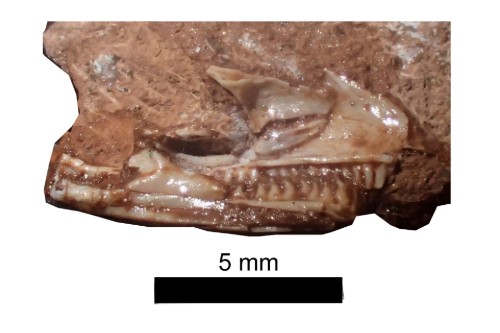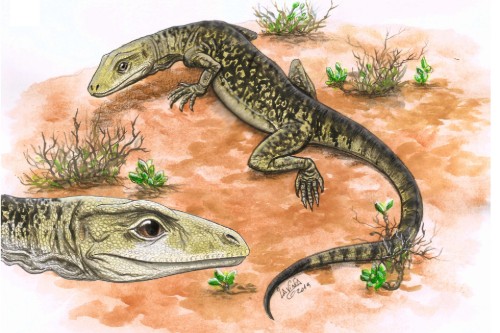
Lizard fossil - the skull in side view.David Whiteside

Life restoration of the earliest lizard, Cryptovaranoides microlanius. Length of adult animal is about 25 cm.Lavinia Gandolfi
A storeroom specimen that changed the origins of modern lizards by millions of years has had its identity confirmed.
The tiny skeleton, unearthed from Triassic-aged rocks in a quarry near Bristol, is at least 205 million years old and the oldest modern-type lizard on record.
Recently, the University of Bristol team's findings came under question, but fresh analysis, published today in Royal Society Open Science, proves that the fossil is related to modern anguimorphs such as anguids and monitors. The discovery shifts the origin of the whole lizard-snake group, called Squamata, back by 35 million years.
In the original study, Dr David Whiteside, Dr Sofia Chambi-Trowell and Professor Mike Benton, named the little critter Cryptovaranoides microlanius, meaning 'hidden lizard, small butcher' because of its identification as a lizard and its sharp teeth, probably used for cutting up prey animals for food. The School of Earth Sciences team identified many anatomical features of the skull and skeleton that allowed them to place it well within Squamata, and even close to the Anguimorpha.
"We knew our paper would be controversial," explained Dr Whiteside. "But we were confident that we had looked at every possible feature and compared it with everything we could."
Professor Benton said: "We were therefore surprised, perhaps even shocked, that in 2023 another team of academics suggested that Cryptovaranoides was not a lizard or even a lizard relative, but in fact an archosauromorph, more closely related to crocodilians and dinosaurs."
In checking their original work, and the questions posed in the rival paper, the Bristol team explored all the data, including the original specimen as well as the X-ray scans that show the details hidden within the rock. "We had the marvellous images from those CT scans as well as further access to the fossil which enabled us to check all their suggestions," said Dr Chambi-Trowell. "We found that most of the concerns raised were wrong."
Professor Benton added: "All the details of the skull, the jaws, the teeth, and the limb bones confirm that Cryptovaranoides is a lizard, not an archosauromorph.
"In our new paper, we provide great detail of every criticism made and we provide more photographs of the specimen and 3D images from the scans, so everyone can check the detail."
Dr Whiteside concluded: "The result of all this had to be tested by a phylogenetic analysis.
"This is where we code hundreds of anatomical features in Cryptovaranoides and other modern and fossil lizards, as well as various archosauromorphs.
"We ran the analysis time after time, and it gave our original result, that the little Bristol reptile is indeed the world's oldest modern-type lizard."
The paper
'Late Triassic Cryptovaranoides microlanius is a squamate, not an archosauromorph' by D Whiteside, Sofia Chambi-Trowell and Mike Benton MJ in Royal Society Open Science.






